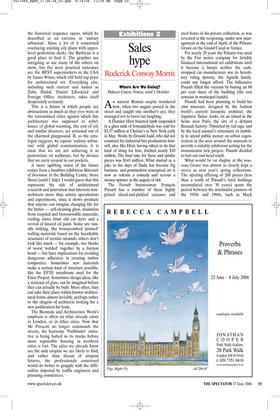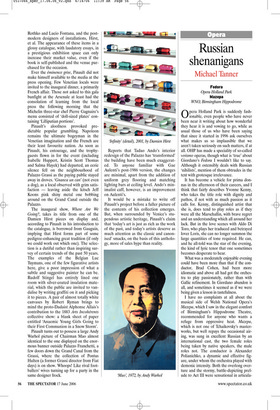Sales hype
Roderick Conway Morris
Where Are We Going? Palazzo Grassi, Venice, until 1 October
An ancient Roman sceptic wondered how, when two augurs passed in the street and caught one another’s eye, they managed not to burst out laughing.
A Damien Hirst bisected lamb suspended in a glass tank of formaldehyde was sold for $3.37 million at Christie’s in New York early in May. Works by Donald Judd, who did not construct his industrial box productions himself, also, like Hirst, having others to do that kind of thing for him, fetched nearly $10 million. The final take for these and similar pieces was $143 million. What started as a joke in the days of Dada has become big business, and postmodern conceptual art is now as solemn a comedy and serious a money-spinner as the augury of old.
The French businessman François Pinault has a number of these highly priced sliced-and-pickled carcases and steel boxes in his private collection, as was revealed at the reopening, under new management at the end of April, of the Palazzo Grassi on the Grand Canal in Venice.
For nearly 20 years the Palazzo was used by the Fiat motor company for lavishly financed international art exhibitions until it became a luxury neither the cashstrapped car manufacturer nor its hereditary ruling dynasty, the Agnelli family, could any longer afford. The billionaire Pinault filled the vacuum by buying an 80 per cent share of the building (the rest remains in municipal hands).
Pinault had been planning to build his own museum, designed by the fashion world’s current favourite architect, the Japanese Tadao Ando, on an island in the Seine near Paris, the site of a defunct Renault factory. Thwarted by red tape and by the local council’s reluctance or inability to spend public money on urban regeneration in the area around the museum to provide a suitably salubrious setting for the monumental new project, Pinault decided to bail out and head south.
What would be on display at the nouveau Grassi was almost as closely kept a secret as next year’s spring collections. The opening offering of 200 pieces (less than a tenth of Pinault’s total holdings accumulated over 30 years) spans the period between the minimalist painters of the 1950s and 1960s, such as Mark Rothko and Lucio Fontana, and the postmodern designers of installations, Hirst, et al. The appearance of these items in a glossy catalogue, with laudatory essays, in a prestigious exhibition space can only increase their market value, even if the book is self-published and the venue purchased for the occasion.
Ever the éminence grise, Pinault did not make himself available to the media at the press opening. Few Venetian locals were invited to the inaugural dinner, a primarily French affair. Those not asked to this gala bunfight at the Arsenale at least had the consolation of learning from the local press the following morning that the Michelin three-star chef Pierre Gagnaire’s menu consisted of ‘doll-sized plates’ containing ‘Lilliputian portions’.
Pinault’s aloofness provoked predictable popular grumbling. Napoleon remains the ultimate bogeyman in the Venetian imagination and the French are their least favourite nation. As soon as Pinault, his entourage, and the trophyguests flown in for the event (including Isabelle Huppert, Kristin Scott Thomas and Salma Hayek) had departed, an eerie silence fell on the neighbourhood of Palazzo Grassi as the paying public stayed away in droves. ‘Gnanca un can’ (not even a dog), as a local observed with grim satisfaction — leaving aside the kitsch Jeff Koons pink shiny metal one bobbing around on the Grand Canal outside the Palazzo.
The inaugural show, Where Are We Going?, takes its title from one of the Damien Hirst pieces on display and, according to Pinault in his introduction to the catalogue, is borrowed from Gauguin, implying that Hirst forms part of some pedigree-enhancing great tradition (if only we could work out which one). The selection is a dutiful rather than inspiring survey of certain trends of the past 50 years. The examples of the Belgian Luc Tuymans, one of the few figurative artists here, give a poor impression of what a subtle and suggestive painter he can be. Rudolf Stingel has entirely lined one room with silver-coated insulation material, which the public are invited to vandalise by writing graffiti on it and picking it to pieces. A pair of almost totally white canvases by Robert Ryman brings to mind the proto-Dadaist Alphonse Allais’s contribution to the 1883 Arts Incohérents collective show: a blank sheet of paper entitled ‘Anaemic Young Girls Going to their First Communion in a Snow Storm’.
Pinault turns out to possess a large Andy Warhol picture of Chairman Mao almost identical to the one displayed on the enormous banner outside Palazzo Franchetti, a few doors down the Grand Canal from the Grassi, where the collection of Pontus Hulten (a former Grassi director from Fiat days) is on show. Whoops! Like rival footballers’ wives turning up for a party in the same designer frock. Reports that Tadao Ando’s interior redesign of the Palazzo has ‘transformed’ the building have been much exaggerated. To anyone familiar with Gae Aulenti’s post-1986 version, the changes are minimal, apart from the addition of uniform grey flooring and matching lighting bars at ceiling level. Ando’s minimalist caff, however, is an improvement on Aulenti’s.
It would be a mistake to write off Pinault’s project before a fuller picture of the contents of his collection emerges. But, when surrounded by Venice’s stupendous artistic heritage, Pinault’s claim that ‘today’s art is just as rich as the work of the past, and today’s artists deserve as much attention as the classic and canonised’ smacks, on the basis of this anthology, more of sales hype than reality.



















































































 Previous page
Previous page